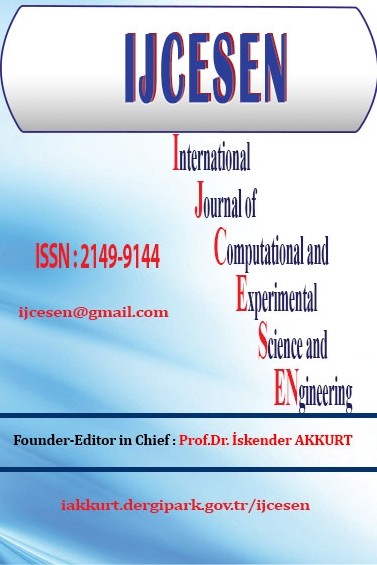Virtual Reality Applications in Industrial Automation Systems: Industrial Robot Station Application
Virtual Reality Applications in Industrial Automation Systems: Industrial Robot Station Application
___
- A. Aras, M. Ayaz, E. Özdemir, N. Abut, “Investigation on Industry 4.0 and Virtual Commissioning”, International Journal of Engineering and Technologies - IJET, vol. 4, no. 2, pp. 107-113, 2018.
- M. F. Silva, “World Model Creation in ABB RobotStudio 5.15.02”, ISEP - Instituto Superior de Engenharia do Porto, Project: ROBIN - Simulation and Offline Programming of Industrial Robots, 2016.
- M. F. Silva, “Targets Creation in ABB RobotStudio 5.15.02,” ISEP - Instituto Superior de Engenharia do Porto, Project: ROBIN - Simulation and Offline Programming of Industrial Robots, 2016.
- M. F. Silva, “Program Creation in ABB RobotStudio 5.15.02,” ISEP - Instituto Superior de Engenharia do Porto, Project: ROBIN - Simulation and Offline Programming of Industrial Robots, 2016.
- M. F. Silva, “Simulation of the Robot Program in the Virtual Controller,” ISEP - Instituto Superior de Engenharia do Porto, Project: ROBIN - Simulation and Offline Programming of Industrial Robots, 2016.
- M. F. Silva, “Mechanism Creation in ABB RobotStudio 5.15.02,” ISEP - Instituto Superior de Engenharia do Porto, Project: ROBIN - Simulation and Offline Programming of Industrial Robots, 2016.
- V. Cohal, “A Welding Technology Using RobotStudio,” in 21st Innovative Manufacturing Engineering & Energy International Conference – IManE&E 2017, Iasi, Romania, 2017, pp. 1-6.
- F. M. Moura, M. Silva, “Application for Automatic Programming of Palletizing Robots,” in 18th IEEE International Conference on Autonomous Robot Systems and Competitions, Torres Vedras, Portugal, 2018, pp. 1-5.
- R. Holubek, P. Košťál, D. R. D. Sobrino, R. Roman, “Offline Programming of an ABB Robot Using Imported CAD Models in the RobotStudio Software Environment,” Applied Mechanics and Materials, vol. 693, pp. 62-67, 2014.
- C. Şekerci, “Sanal Gerçeklik Kavramının Tarihçesi,” Uluslararası Sosyal Araştırmalar Dergisi, c. 10, s. 54, ss. 1126-1133, 2017.
- E. Bayraktar, F. Kaleli, “Sanal Gerçeklik ve Uygulama Alanları,” Akademik Bilişim Konferansı, Kütahya, Türkiye, 2007, ss. 1-6.
- T. Tepe, D. Kaleci, H. Tuzun, “Eğitim Teknolojilerinde Yeni Eğilimler: Sanal Gerçeklik Uygulamaları,” 10th International Computer and Instructional Technologies Symposium, Rize, Türkiye, 2016, ss. 1-5.
- Ç. Erbaş, V. Demirer, “Eğitimde Sanal ve Artırılmış Gerçeklik Uygulamaları,” Eğitim Teknolojileri Okumaları 2015, 1. baskı. Ankara, Türkiye: The Turkish Online Journal of Educational Technology, 2015, böl. 7, ss. 131-148.
- S. Gökoğlu, M. Öztürk, F. Erdoğdu, Ü. Çakıroğlu, “Öğrenme Ortamlarında Sanal Dönüşümler: Sanal Gerçeklik Yaklaşımı,” Eğitim Teknolojileri Okumaları 2017, 1. baskı. Ankara, Türkiye: The Turkish Online Journal of Educational Technology, 2017, böl. 23, ss. 423-434.
- R. Ekici, A. Güven, “Sanal Gerçeklik Teknolojisinin Turizm Endüstrisindeki Rolü,” Avrasya Bilimler Akademisi Sosyal Bilimler Dergisi, c. 2017, s. UTKM, ss. 403-418, 2017.
- E. Üzümcü, B. Akın, H. Nergiz, M. İnözü, U. Çelikcan, “Anksiyete Bozukluklarında Sanal Gerçeklik,” Psikiyatride Güncel Yaklaşımlar, c. 10, s. 1, ss. 99-117, 2018.
- G. C. Quinn, A. Galeazzi, C. Gengnagel, “Augmented and Virtual Reality Structures,” in Proceedings of the IASS Annual Symposium 2017: Interfaces: architecture, engineering, science, Hamburg, Germany, 2017, pp. 1-8.
- D. Yengin, “Virtual Reality as Technology,” in Communication and Technology Congress – CTC 2017, Istanbul, Turkey, 2017, pp. 57-68.
- Anonim, (15 March 2018). [Online]. Erişim: https://www.usgamer.net/articles/htc-vive-virtual-reality-systemdeluxe-audio-strap-549-black-friday-sale
- Yayın Aralığı: 4
- Başlangıç: 2015
- Yayıncı: Prof.Dr. İskender Akkurt
Characterization and siderophores production of Rhizobium spp. isolated from wild legumes
Nazmiye Deniz ARSLAN, H. Orhan KIZILKAYA, Ayşe KUTLUHAN
Melise KARATAY KUTMAN, Fazilet Zümrüt BİBER MÜFTÜLER, Özge KOZGUŞ GÜLDÜ, Coşkun HARMANŞAH
Aniekan IKPE, Akanu-ıbiam NDON, Promise ETİM
Modeling Hyperelastic Materials by MATLAB
Ahmad ALDEEN, Yücel CAN, Murat YAZICI
Calculated hyperfine coupling constants of some sigma-type radicals
Medical Data Analysis for Different Data Types
Virtual Reality Applications in Industrial Automation Systems: Industrial Robot Station Application
